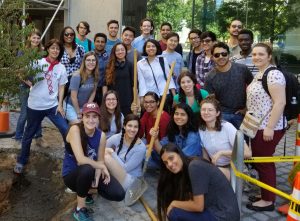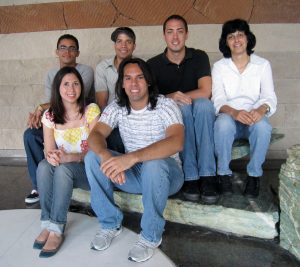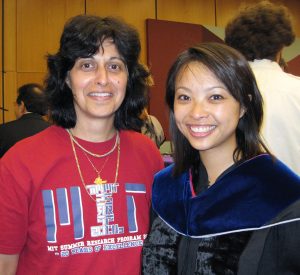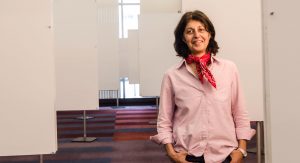Two decades of biology outreach
A lifelong interest in teaching brought Mandana Sassanfar to MIT, where she has established programs to engage diverse students and forged partnerships with institutes across the country.
Raleigh McElvery
Of all the offices in Building 68, Mandana Sassanfar’s is perhaps the most colorful. Her walls are lined with photos of students past and present, each of whom completed one or more of the six outreach programs she heads as the Department of Biology’s director of outreach. Over the last two decades, Sassanfar has forged partnerships with communities across the country, in an effort to engage historically underrepresented groups in science — and increase access to MIT’s on-site and online resources.
Although she was born in Switzerland, Sassanfar spent most of her childhood moving between France and Iran for her father’s job. No matter where her family lived, she always attended French-speaking schools. As early as fourth grade, she remembers analyzing her instructors’ teaching strategies, and practicing how she would explain the same concepts to make them clearer. While this interest in education continued to percolate, she also discovered that her favorite subjects were chemistry and math.
By 1983, she’d earned a master’s in biochemistry from Pierre and Marie Curie University in Paris, and moved to the US to start a PhD at Cornell University. Although she nearly switched tracks to study plant science, she ultimately stuck with biochemistry in the hopes of studying under well-known scientist Jeffery Roberts. Although Roberts was not taking new students at the time, Sassanfar convinced him to let her complete an eight-week rotation in his lab.
“I scheduled that rotation as my last, so I would have made every mistake before working with Jeff’s group,” she says. “At the end of the eight weeks, I literally told him, ‘If you don’t take me, I’m going back to France.’ And he took me in.”
While everyone else was probing various aspects of transcription antitermination, Sassanfar was an outlier investigating the role of DNA replication in the bacterial SOS repair pathway following DNA damage. She was among the first researchers to design a quantitative western blot assay to measure the level of LexA and RecA proteins in vivo. “Jeff’s lab was a wonderful place to work and I received a rigorous scientific training,” she recalls. “He was an excellent mentor.”
After graduating from Cornell in 1988, Sassanfar completed two postdocs: one with Leona Samson at the Harvard School of Public Health, and another with Jack Szostak at Massachusetts General Hospital (MGH). Szostak later went on to earn a Nobel Prize in Physiology or Medicine for discovering how chromosomes are protected by telomeres and telomerase enzymes. While Sassanfar was in his lab, she overlapped with many prominent scientists, including David Bartel, Jennifer Doudna, Rachel Green, and John Lorsch.

As Sassanfar’s time at MGH drew to a close, Szostak introduced her to Paul Schimmel, a long-time faculty member at the MIT Department of Biology, who was hiring research scientists for his new biotech startup, Cubist, which he had co-founded with chemistry professor Julius Rebek. The company intended to explore aminoacyl-tRNA synthetases as potential antibiotic targets. Sassanfar already knew Schimmel as the co-author of one of her favorite books, Biophysical Chemistry. But working with him for nearly four years taught her additional skills that she couldn’t have gleaned from a book.
“I came to understand a tremendous amount about the biotech culture while I was at Cubist,” she says. “Paul was a great mentor, and I learned a lot from him about writing papers, and watching the even-keeled way he interacts with people.”
When Schimmel eventually moved to The Scripps Research Institute, Sassanfar joined Harvard University’s Department of Molecular and Cellular Biology as a teaching fellow. There, professor Stephen Harrison, a Howard Hughes Medical Institute (HHIM) Investigator, offered her a chance to become involved in her first outreach program — a week-long workshop for high school teachers that she continues to run today from MIT. She was also charged with coordinating a summer program that placed non-Harvard undergraduates in campus labs each summer. But, in 2002, just a couple months before a student cohort was slated to arrive, the program was abruptly canceled and Sassanfar resigned.
“I had to transfer six undergraduates to other summer programs and find a space for the teacher’s summer workshop,” she remembers. “I just needed some lab space for two weeks.”
She called the MIT Department of Biology, and within a few days she not only had lab spaces for the teachers workshop, but a job offer as well. She accepted, and teamed up with professor Graham Walker. Together, they worked to expand the department’s pre-college and undergraduate outreach programs, creating a pipeline to graduate school in the process.
While many graduate institutions are quick to recruit students from Ivy League schools, Sassanfar saw an opportunity to widen the applicant pool. “If you decide that all the top students are from the Ivies — which is not true — then you’re missing out on many phenomenal applicants,” she says. “So I started reaching out to undergraduate institutions with limited research resources that serve diverse student bodies. Graham and I wanted to offer these students a comprehensive summer research experience, which would inspire them to apply to rigorous PhD programs like MIT Biology.”
MIT already offered some programs in this vein — such as the MIT Summer Research Program (now called “MSRP General”) — but none of them focused specifically on the life sciences. And, MSRP General was not specifically designed to be a recruiting tool for the Department of Biology. As a result, Walker and Sassanfar decided to establish the MIT Summer Research Program in Biology (MSRP-Bio), which would offer additional, biology-specific programming to help these trainees succeed and prepare them for the next stage of their careers.
Walker was the long-time program director of the HHMI Undergraduate Science Education Program at MIT, and was also named an HHMI professor the year Sassanfar arrived. He and Sassanfar used some of the accompanying funds to establish synergetic programs focused on education outreach and diversity. These included MSRP-Bio, the Quantitative Biology Workshop, the HHMI special seminar series, and a summer mini-sabbatical for faculty at institutions serving students from disadvantaged backgrounds and minority groups.

“When Mandana began at MIT, she realized that to compete for the most talented students we needed to strengthen the biology component of MIT’s summer research programs, by increasing our outreach efforts and developing an enriched summer experience,” Walker recalls. “Since then, her leadership, energy, enthusiasm, and humanity have helped MSRP-Bio develop into the strikingly successful, high-impact program that it is today.”
At first, Sassanfar says, she didn’t know much about the MIT Biology philosophy or the graduate program. “I spent a lot of time just talking to the grad students. And I realized that if we were going to use MSRP-Bio as a recruiting tool, then we had to set admission standards similar to those of the graduate program.”
She began by tweaking the admissions process, raising the minimum GPA and requiring additional letters of recommendation. That first summer, Sassanfar and Walker had only a few months to prepare, so the inaugural 2003 cohort was just 11 students.
Today, the program is known as the Bernard S. and Sophie G. Gould MIT Summer Research Program in Biology (BSG-MSRP-Bio), and hosts up to 20 students. Participants perform full-time research for 10 weeks between June and August. They also attend academic seminars and weekly meetings with faculty. They visit biotech labs, take tours of Boston, learn about the grad school application process, practice their presentation skills, and share their research projects at the MSRP poster session and other conferences around the country.
In order to attract applicants from across the country, Sassanfar began traveling annually to schools with large populations of under-represented minority students, such as historically black colleges and universities; Hispanic-serving institutions; and large state schools in Texas, Florida, New York, Maryland, and Puerto Rico. She often relied on MSRP-Bio alumni to introduce her to science faculty during her campus visits.
At first it was difficult to connect with administrators and meet students. But Sassanfar slowly built sturdy relationships, and even started inviting faculty to join their students at MIT for seminars and summer sabbaticals. In 2004, the biotechnology program at the University Puerto Rico at Mayagüez honored Sassanfar with an award to celebrate her work.
“It’s really important to create opportunities that allow diverse students and faculty to benefit from MIT, rather than the other way around,” she says. “You have to show that you are doing this because you care, and not because you want something in return.”
Since 2003, over 400 students from 39 countries have participated in MSRP-Bio. Over 75% have gone on to graduate school (including 87 at MIT), 12 have become professors, and many others are leading successful careers in industry or medicine. One alumnus from the 2005 cohort, Eliezer Calo, is now a faculty member in the Department of Biology, and another from the 2007 cohort, Francisco Sánchez-Rivera, will start his own lab at the Koch Institute in 2022. Many of the MSRP-Bio alumni who complete their PhDs and postdocs at MIT stay actively engaged in outreach programs until they graduate, and help Sassanfar with many of the programs she coordinates.

Mary Lee, a member of MSRP-Bio’s inaugural cohort who later completed her PhD at MIT, says she applied to the program in hopes of experiencing cutting-edge biology research in a new city. “Mandana was an integral part of my experience in MSRP-Bio,” she explains. “From my first encounter with her to even now, 20 years later, it is clear how committed she is to connecting students like myself to MIT and the research community. It was a short summer but the experience unlocked opportunities for me that I would not have had otherwise.”
Sassanfar also serves as the director of diversity and science outreach for the Department of Brain and Cognitive Sciences, as well as the diversity coordinator for the Center for Brains, Minds and Machines. These additional roles have allowed her to expand MSRP-Bio and the Quantitative Biology Workshop, now known as the Quantitative Methods Workshop. In addition, she’s spearheaded programs for local high school students, including field trips and the LEAH Knox Scholars Program.
Beyond her outreach work, each winter during MIT’s Independent Activities Period she teaches a class for first-year MIT undergraduates to introduce them to biology lab techniques. “My favorite thing is seeing the looks on students’ faces when they have been working so hard to learn and apply techniques, and they finally can see and interpret the results of their experiments,” she says. “That’s what I love.”
Although Sassanfar has mentored hundreds of students over the past 20 years, she works hard to connect with each while they’re on campus, and has stayed in touch with many of them. She enjoys getting visits and emails from summer program alums who share their successes and thank her for the role she’s played.
“The fact that we have so many students who have finished their PhDs and gone on to become postdocs, faculty, doctors and important players in industry is, I think, truly where the success lies,” she says. “My hope is to build a strong network of alums who are excited to meet current students and create a community.”
Most recently, Sassanfar has teamed up with students, staff, and faculty from the Department of Biology to begin a new initiative, which provides research training opportunities to local community college students.
“What has really worked for me is that the Biology Department gives me free rein,” she says. “They provide their full support, and let me take it from there.”

